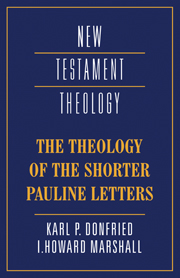Book contents
- Frontmatter
- Contents
- Editor's preface
- List of abbreviations
- THE THEOLOGY OF I THESSALONIANS
- THE THEOLOGY OF 2 THESSALONIANS
- THE THEOLOGY OF PHILIPPIANS
- Author's note
- 9 Exploring the building site
- 10 Laying the foundation
- 11 Building the walls
- 12 The shape of the Church
- 13 Philippians and its architect
- 14 A building that still stands
- THE THEOLOGY OF PHILEMON
- Select bibliography
- Indices (Thessalonians)
- Indices (Philippians, Philemon)
13 - Philippians and its architect
Published online by Cambridge University Press: 05 June 2012
- Frontmatter
- Contents
- Editor's preface
- List of abbreviations
- THE THEOLOGY OF I THESSALONIANS
- THE THEOLOGY OF 2 THESSALONIANS
- THE THEOLOGY OF PHILIPPIANS
- Author's note
- 9 Exploring the building site
- 10 Laying the foundation
- 11 Building the walls
- 12 The shape of the Church
- 13 Philippians and its architect
- 14 A building that still stands
- THE THEOLOGY OF PHILEMON
- Select bibliography
- Indices (Thessalonians)
- Indices (Philippians, Philemon)
Summary
Having seen something of the theology expressed in Philippians, we must now attempt to ‘place’ it in relation to other NT documents. Space precludes anything more than a comparison with other Pauline documents. In terms of our ‘building’ metaphor, we want to compare Philippians with other structures designed by the same builder to see how far they express the same basic design adapted to different situations. According to J. C. Beker, whatever theological differences exist between the various letters of Paul may be explained in terms of the categories of ‘coherence’ and ‘contingency’. Beker sees in the mind of Paul a coherent system of thought which is developed in appropriate ways according to the different contingent circumstances in which he is writing. We shall look at four main areas.
CHRISTOLOGY
What kind of christology is presented in Philippians? Here we have one of the most explicit utterances of Paul on the subject. Can we determine its character? Numerous attempts have been made to categorise it.
Adam christology
A contrast between Adam and Christ is possible. Adam too was made in the image of God, and in Jewish thought was endowed with sovereignty over creation; man is a little lower than the angels and crowned with glory and honour (Ps. 8). Where Adam fell, Jesus resisted temptation.
This line of thought has been popular with exegetes who have had difficulty in attributing the concept of pre-existence, as traditionally understood, to Paul or to a pre-Pauline source. The contrast between Adam and Christ is familiar elsewhere in Paul (Rom. 5, 1 Cor. 15).
- Type
- Chapter
- Information
- The Theology of the Shorter Pauline Letters , pp. 162 - 166Publisher: Cambridge University PressPrint publication year: 1993

